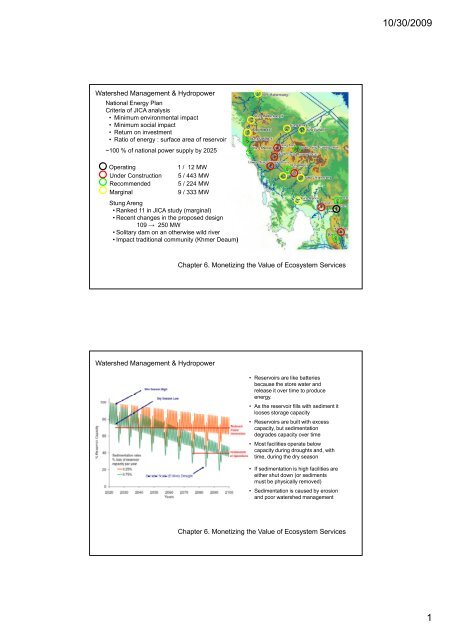Watershed management and hydropower
Watershed management and hydropower
Watershed management and hydropower
- No tags were found...
You also want an ePaper? Increase the reach of your titles
YUMPU automatically turns print PDFs into web optimized ePapers that Google loves.
10/30/2009<strong>Watershed</strong> Management & HydropowerNational Energy PlanCriteria of JICA analysis• Minimum environmental impact• Minimum social impact• Return on investment• Ratio of energy : surface area of reservoir~100 % of national power supply by 2025Operating1 / 12 MWUnder Construction 5 / 443 MWRecommended 5 / 224 MWMarginal9 / 333 MWStung Areng• Ranked 11 in JICA study (marginal)• Recent changes in the proposed p design109 → 250 MW• Solitary dam on an otherwise wild river• Impact traditional community (Khmer Deaum)Chapter 6. Monetizing the Value of Ecosystem Services<strong>Watershed</strong> Management & Hydropower• Reservoirs are like batteriesbecause the store water <strong>and</strong>release it over time to produceenergy.• As the reservoir fills with sediment itlooses storage capacity• Reservoirs are built with excesscapacity, but sedimentationdegrades capacity over time• Most facilities operate belowcapacity during droughts <strong>and</strong>, withtime, during the dry season• If sedimentation is high facilities areeither shut down (or sedimentsmust be physically removed)• Sedimentation is caused by erosion<strong>and</strong> poor watershed <strong>management</strong>Chapter 6. Monetizing the Value of Ecosystem Services1
10/30/2009<strong>Watershed</strong> Management & HydropowerEconomic model showing the cost ofpoor watershed <strong>management</strong> <strong>and</strong>reduced generating capacityGrey:Red:Green:Excess capacityCapacity in well managedwatershedCapacity in poorlymanaged watershedOrange:Green:Lost revenue during thefirst 30 years of the facility(contractor period in BOT)Lost revenue during thefollowing 70 years(Nat. Electrical Authority)Chapter 6. Monetizing the Value of Ecosystem Services1.NostalgicPastThe LCM modelsproject the spatial2.distribution ib ti ofTimbre,deforestation overGold <strong>and</strong>three temporalCattleperiods (redareas) withdifferent3a.deforestationInsufficientrates <strong>and</strong>REDDassumptionsconcerning l<strong>and</strong>use(see text).3b.EffectiveREDD2
10/30/2009Millions tCO21,8001,6001,4001,2001,000800600400200-20102012201420162018Cumulative National Emissions (tons CO2)BAU vs Effective REDDBusiness As UsualEffective REDD20342032203020282026202420222020203620382040Mean AnnualEmissionsReductions =44.827m tCO2Potential REDD revenuesprojected over a 30 yearperiod based on a comparisonbetween the Cattle, Gold <strong>and</strong>Timber Scenario (2) as thereference scenario <strong>and</strong> theEffective REDD scenario (3b)as the eventual outcome; inboth instances, the modelcontemplates bothdeforestation <strong>and</strong> forestdegradation.Emissions Reductions in Effective REDD (tons CO2)Total Emissions ReductionsOver 30yr 1,389,662,918Mean AnnualReductions 44,827,836Effective REDD 30yr Revenue Projections$2/ton CO2 $5/ton $10/tonTotal Revenue Constant USD $2,779,325,836 $6,948,314,591 $13,896,629,182Mean Annual Revenue $ 89,655,672 $ 224,139,180 $ 448,278,361Mean Annual Revenue (disc) $ 26,593,587 $ 66,483,969 $ 132,967,937NPV @ 10% $815,606,897 $2,039,017,242 $4,078,034,483Potential National REDD RevenueEffective REDD ScenarioUSDM illions$350$300$250$304Discounted Annual Flows @ $2 tCO2Discounted Annual Flows @ $5 tCO2Discounted Annual Flows @ $10 tCO2Cumulative Emissions Reductions1,6001,4001,200tons CO2M illio n s1,000$200800$150$100Mean Annual Payments:$26.59m @ $2 tCO2$66.48m @ $5 tCO2$132.96m @ $10 tCO2600400$50$20200$--204020392038203720362035203420332032203120302029202820272026202520242023202220212020201920182017201620152014201320122011YearChapter E: Analysis of Financial Flows from REDD Activities In GuyanaRobert O'Sullivan <strong>and</strong> Agustin Silvani3
10/30/20094





